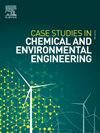Minimal effect of raw water turbidity on operational energy use of drinking water treatment
Q1 Environmental Science
Case Studies in Chemical and Environmental Engineering
Pub Date : 2025-09-11
DOI:10.1016/j.cscee.2025.101282
引用次数: 0
Abstract
The energy use of drinking water treatment plants (WTPs) depends on several variables, and while processes within the plant have been analyzed, the effect of raw water quality on energy use is less well studied. We analyze raw water turbidity, energy (electricity) use, and production volume in eight WTPs in Utah, USA, over a multi-year period. As expected, we find seasonal trends in energy use, turbidity, and production volume that correspond with watershed and water demand conditions. However, we find no significant relationship between influent turbidity and energy use. This is somewhat counterintuitive since one might assume that more turbid water is more difficult to treat. While higher turbidity does affect WTP operation (e.g., more chemical dosing and backwashing), it appears that the incremental energy use is minimal compared to the baseline. While consistently high turbidity might prompt the selection of a more energy-intensive process during WTP design, we conclude that, for a given WTP, typical operational fluctuations in turbidity do not meaningfully increase energy use.
原水浊度对饮用水处理运行能耗的影响最小
饮用水处理厂(WTPs)的能源使用取决于几个变量,虽然对工厂内的过程进行了分析,但对原水质量对能源使用的影响的研究较少。我们分析了美国犹他州八个污水处理厂多年来的原水浊度、能源(电力)使用和产量。正如预期的那样,我们发现能源使用、浑浊度和产量的季节性趋势与流域和水需求条件相对应。然而,我们发现进水浑浊度和能源使用之间没有显著的关系。这有点违反直觉,因为人们可能会认为越浑浊的水越难以处理。虽然较高的浊度确实影响WTP操作(例如,更多的化学剂量和反冲洗),但与基线相比,增加的能源使用似乎是最小的。虽然持续的高浊度可能促使在WTP设计期间选择更耗能的工艺,但我们得出的结论是,对于给定的WTP,浊度的典型操作波动不会有意地增加能源使用。
本文章由计算机程序翻译,如有差异,请以英文原文为准。
求助全文
约1分钟内获得全文
求助全文
来源期刊

Case Studies in Chemical and Environmental Engineering
Engineering-Engineering (miscellaneous)
CiteScore
9.20
自引率
0.00%
发文量
103
审稿时长
40 days
 求助内容:
求助内容: 应助结果提醒方式:
应助结果提醒方式:


